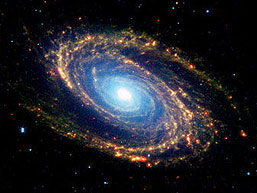 WASHINGTON (AFP) - A bus-sized US satellite that hurtled unpredictably toward Earth crossed over Africa and the northern Atlantic before likely plunging into the Pacific Ocean off California, NASA said on Saturday.
WASHINGTON (AFP) - A bus-sized US satellite that hurtled unpredictably toward Earth crossed over Africa and the northern Atlantic before likely plunging into the Pacific Ocean off California, NASA said on Saturday.
The six-tonne Upper Atmosphere Research Satellite (UARS) fell from the sky between 11:23 pm Friday and 1:09 am Saturday (0323-0509 GMT Saturday), the space agency said, but there were no sightings or reliable accounts of damage.
"We have got no reports of anyone seeing anything that we believe are credible," NASA chief orbital scientist Nick Johnson said, noting that the "vast majority" of its flight track had been over water.
The best and latest estimate, made by the Joint Space Operations Center at Vandenberg Air Force Base in California at two hours before entry, put the re-entry time at 0416 GMT.
"If the re-entry point was at 0416 GMT, then all that debris wound up in the Pacific Ocean," said Johnson.
NASA had maintained that the risk of the satellite causing harm to people on land was remote.
Since the satellite was circling Earth just about every hour and a half before it fell, it covered a vast amount of territory in its final loop, according to a map NASA posted on its website at nasa.gov/uars.
It started off on the eastern coast of Africa before going over the Indian Ocean, up the Pacific over Canada, over the northern Atlantic and then down western Africa before ending in the Indian Ocean again, Johnson said.
The final resting place of the 20-year-old satellite's remains could stay shrouded in mystery.
"We may never know," Johnson said, noting that NASA relies on the public as well as aviation and naval personnel to report evidence of satellite debris.
The satellite was expected to break into 26 pieces as it plummeted toward Earth, with surviving parts including titanium fuel tanks, beryllium housing and stainless steel batteries and wheel rims.
"Twenty-six satellite components, weighing a total of about 1,200 pounds (550 kilograms), could have survived the fiery re-entry and reach the surface of Earth. However, NASA is not aware of any reports of injury or property damage," the space agency said.
UARS was launched in 1991 to measure the ozone layer and other atmospheric conditions and was decommissioned in 2005. The last of its fuel was used up to change its orbit so it would return to Earth sooner.
Influence from solar activity and the tumbling motion of the satellite made it difficult to narrow down where it would penetrate Earth's atmosphere, and it was expected to leave a 500-mile (800-kilometer) debris footprint.
UARS was the biggest NASA spacecraft to fall since the 85-ton Skylab crashed into western Australia in 1979.
A 40-tonne Russian space station Salyut 7 scattered over Argentina in 1991 after an uncontrolled return to Earth.
Despite the media frenzy that surrounded the UARS landing, orbital debris experts said space junk actually falls from the sky regularly, even weekly, according to Johnson.
"This is not an unusual event. We do not always know where these re-entries occur," he said.
"We have got no reports of anyone seeing anything that we believe are credible," NASA chief orbital scientist Nick Johnson said, noting that the "vast majority" of its flight track had been over water.
The best and latest estimate, made by the Joint Space Operations Center at Vandenberg Air Force Base in California at two hours before entry, put the re-entry time at 0416 GMT.
"If the re-entry point was at 0416 GMT, then all that debris wound up in the Pacific Ocean," said Johnson.
NASA had maintained that the risk of the satellite causing harm to people on land was remote.
Since the satellite was circling Earth just about every hour and a half before it fell, it covered a vast amount of territory in its final loop, according to a map NASA posted on its website at nasa.gov/uars.
It started off on the eastern coast of Africa before going over the Indian Ocean, up the Pacific over Canada, over the northern Atlantic and then down western Africa before ending in the Indian Ocean again, Johnson said.
The final resting place of the 20-year-old satellite's remains could stay shrouded in mystery.
"We may never know," Johnson said, noting that NASA relies on the public as well as aviation and naval personnel to report evidence of satellite debris.
The satellite was expected to break into 26 pieces as it plummeted toward Earth, with surviving parts including titanium fuel tanks, beryllium housing and stainless steel batteries and wheel rims.
"Twenty-six satellite components, weighing a total of about 1,200 pounds (550 kilograms), could have survived the fiery re-entry and reach the surface of Earth. However, NASA is not aware of any reports of injury or property damage," the space agency said.
UARS was launched in 1991 to measure the ozone layer and other atmospheric conditions and was decommissioned in 2005. The last of its fuel was used up to change its orbit so it would return to Earth sooner.
Influence from solar activity and the tumbling motion of the satellite made it difficult to narrow down where it would penetrate Earth's atmosphere, and it was expected to leave a 500-mile (800-kilometer) debris footprint.
UARS was the biggest NASA spacecraft to fall since the 85-ton Skylab crashed into western Australia in 1979.
A 40-tonne Russian space station Salyut 7 scattered over Argentina in 1991 after an uncontrolled return to Earth.
Despite the media frenzy that surrounded the UARS landing, orbital debris experts said space junk actually falls from the sky regularly, even weekly, according to Johnson.
"This is not an unusual event. We do not always know where these re-entries occur," he said.




